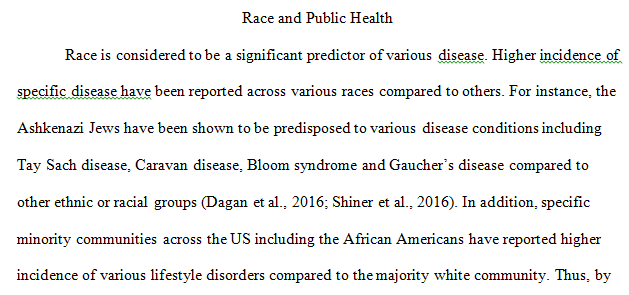
Discuss the ethical and public health implications of this statement.
Race and Public Health
QUESTION2
IMPORTANT NOTE REGARDING WORD LIMIT REQUIREMENTS:
Please note that each and every assignment has its own word limit.
Race is often used as a descriptor of disease burden and helps us to determine where health disparities exist in order to address them, which is important. It is helpful to differentiate between race as a descriptor and race as a risk factor. Think about institutional racism and its influence on health. Consider the factors related to race and ethnicity that might be influencing disease status more than the genetics of race when answering this discussion question.
Consider the following statement: “Race is not a risk factor and should not be used in public health data collection.” Discuss the ethical and public health implications of this statement. When might collecting data on race perpetuate institutional racism leading to health disparities and when is it necessary to improve public health? Provide support and examples for your answer. Consider ethical issues related to respect for persons, beneficence, and justice as described in “The Belmont Report.”
PLEASE ANSWER ALL QUESTIONS IN PARAGRAPHS AND MAKE IT COHESIVE AND TRY TO INCORPORATE THE READINGS BELOW
PLEASE add the links/sites below to the reference list if you use any of these readings and make sure everything is in proper APA format.
https://apastyle.apa.org/learn/quick-guide-on-refe…
Read Chapters 17, 19, and 20 in Gordis Epidemiology.
URL:
https://www.gcumedia.com/digital-resources/elsevier/2019/gordis-epidemiology_6e.php
Read “Health Inequalities Among British Civil Servants: The Whitehall II Study,” by Marmot and Smith, from The Lancet (1991).
URL:
Read “The Role of Epidemiology in Disaster Response Policy Development,” by Thorpe et al., from Science Direct (2015).
URL:
Read “Prescription Drug Abuse: From Epidemiology to Public Policy,” by McHugh, Nielsen, and Weiss, from Journal of Substance Abuse Treatment (2015).
URL:
Read “The Role Epidemiology in Evidence-Based Policy Making: A Case Study of Tobacco Use in Youth,” by Aldrich et al., from Annals of Epidemiology (2015).
URL:
Read “Epidemiology, Policy, and Racial/Ethnic Minority Health Disparities,” by Carter-Pokras et al., from Annals of Epidemiology (2012).
URL:
https://www.ncbi.nlm.nih.gov/pmc/articles/PMC3724931/
Read “Epidemiology and Public Policies,” by Barata, from Revista Brasileira de Epidemiologia (2013).
URL:
http://www.scielo.br/scielo.php?pid=S1415-790X2013000100003&script=sci_arttext&tlng=en
Read “Ethical Issues in Epidemiologic Research and Public Health Practice,” by Coughlin, from Emerging Themes Epidemiology (2006).
URL:
https://www.ncbi.nlm.nih.gov/pmc/articles/PMC1594564/
Explore the “Viral Hepatitis Epidemiologic Profiles” map, located on the Association of State and Territorial Health Officials (ASTHO) website, to assist with topic assignment.
URL:
https://www.astho.org/Viral-Hepatitis-Epi-Profiles/Map/
Use the “BRFSS Web Enabled Analysis Tool,” located on the Centers for Disease Control and Prevention (CDC) website, to complete the topic assignment.
URL:
Review the “Belmont Report,” by the National Commission for the Protection of Human Subjects of Biomedical and Behavioral Research (1979), located on the U.S. Department of Health and Human Services – Office for Human Research Protections website.
URL:
https://www.hhs.gov/ohrp/regulations-and-policy/belmont-report/index.html
Explore the resources on “Health Data Tools and Statistics,” located on the PHPartners website.
URL:
https://phpartners.org/health_stats.html
Explore “Surveillance, Epidemiology and the End Results Program,” from the National Cancer Institute.
URL:
Explore the STEPwise Approach to Surveillance (STEPS) page of the World Health Organization (WHO) website.
URL:
http://www.who.int/chp/steps/en/
MUST have at least three citations with the page numbers and three references in APA format and all questions clearly answered in paragraphs.(The List of References should not be older than 2016 and should not be included in the word count.)
Be sure to support your postings and responses with specific references to the Learning Resources.
It is important that you cover all the topics identified in the assignment. Covering the topic does not mean mentioning the topic BUT presenting an explanation from the context of ethics and the readings for this class
To get maximum points you need to follow the requirements listed for this assignments 1) look at the word/page limits 2) review and follow APA rules 3) create subheadings to identify the key sections you are presenting and 4) Free from typographical and sentence construction errors.
REMEMBER IN APA FORMAT JOURNAL TITLES AND VOLUME NUMBERS ARE ITALICIZED.
Answer preview………………..

apa 594 words